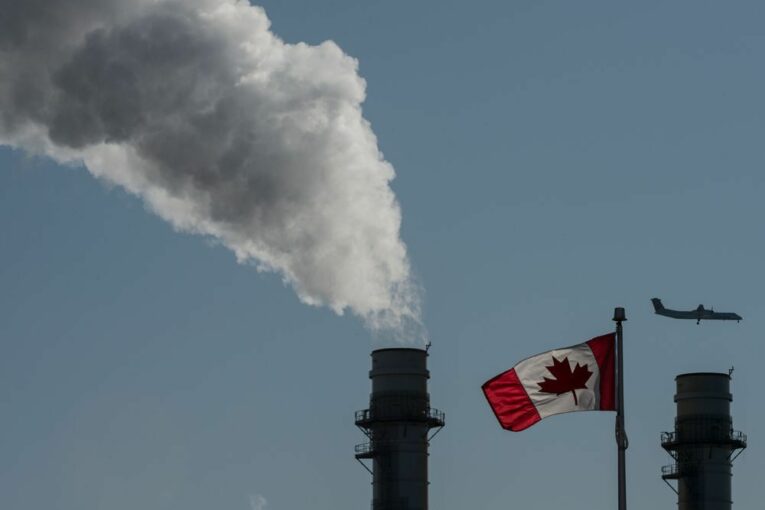
[ad_1]
The Trudeau government pledges Canada will increase oil and gas production to assist Europe’s shift away from Russian energy imports. It’s also pursuing a new plan to sharply reduce emissions from the Canadian oilpatch.
In response, the Kenney government has lambasted the federal emissions reduction strategy as “insane,” a “bad joke,” and “a full-frontal attack” on thousands of energy workers.
Not much ambiguity there.
But how does the Canadian oil and gas sector view these conflicting signals?
Carefully, I suspect.
On the opening day of the annual Scotiabank CAPP Energy Symposium, industry leaders said they’re committed to meeting energy security needs by increasing production to help our European allies move away from oil and gas from Russia following its invasion of Ukraine.
The sector is also prepared to sit down with the federal government to help Ottawa turn its emissions reduction plan into reality, rather than escalate the issue into a full-scale donnybrook.
“We have a commitment from the federal government to work with us,” Crescent Point Energy CEO Craig Bryksa, who is also chair of the Canadian Association of Petroleum Producers, told reporters on Tuesday.
“At the end of the day, it’s sitting down and working through it in a collaborative fashion — and that commitment is there.”
-

Varcoe: Canada’s new climate plan is Alberta’s burden
-

Varcoe: Alberta’s oilpatch faces daunting reality of tough new emissions targets
That’s a much different message than the combative stance from Premier Jason Kenney after Ottawa rolled out its national emissions reduction blueprint last week, which forecast a 42 per cent reduction from the Canadian oilpatch by 2030.
A separate mandatory cap on emissions for the oil and gas industry is coming.
The federal report also contains economic modelling that has caught the province’s attention. It shows Canadian oil production is forecast to continue growing by the end of the decade, but eight per cent below its reference case scenario.
Natural gas output is expected to fall by almost 16 per cent.
Energy Minister Sonya Savage said Tuesday the federal plan isn’t fair as it could limit future production, which falls under provincial oversight.
If federal Environment Minister Steven Guilbeault implements a hard legislated cap on the industry, “that walks entirely into the zone of provincial jurisdiction, and that’s going to be a vicious battle,” she warned.
In an interview, federal Natural Resources Minister Jonathan Wilkinson seemed unperturbed with the province’s response, noting he had “an entirely constructive conversation” with Savage on Monday. He also sat down with oilpatch players during a visit to Calgary.
“It’s important for all of us to dial down the rhetoric a little bit and look to try to engage each other in a collaborative way,” Wilkinson said.
“I would just encourage Premier Kenney to have a conversation with a lot of the folks in the sector that I’ve been speaking with.”
The difference in tone on the matter is striking.
As one government source put it: “A lot of folks are tiptoeing around the real issue. There’s a dance going on right now, and it’s in the early stages.”
The reality is the industry is spending money — and making commitments — to lower its emissions, but the 2030 plan will require even larger investments and significant technological improvements in less than eight years.
Wilkinson dismissed Kenney’s assertion the emissions reduction plan is an attack on energy workers. And boosting production in the short term for energy security reasons while cutting emissions over the long term isn’t at odds, he insisted.
“We want to work with the sector, and the sector today told me they want to work with us.”

One of the first steps of such co-operation could come in Thursday’s federal budget. Ottawa is expected to release details on an investment tax credit for carbon capture, utilization and storage (CCUS) projects, allowing heavy industry to bury emissions deep underground.
The tax credit will be critical for the sector to move ahead on such large projects to lower emissions significantly by 2030 — and reach Canada’s net-zero target by 2050. Six of the largest oilsands operators have already embraced that goal, but are waiting to see details.
The industry also wants a renewed federal focus on getting liquefied natural gas projects built in Canada. Only one project is under construction and more than a dozen proposals have been marooned over the past decade.
Building additional LNG facilities would enable the export of Canadian gas to markets in Asia and Europe, potentially displacing higher-emitting sources of energy, such as coal.
“We have the resource to help the world become cleaner and fight climate change, and also help our neighbours in Europe from an energy security perspective,” ARC Resources CEO Terry Anderson told the symposium.
In the immediate future, increasing production will be a key focus as energy security and affordability issues continue to percolate. West Texas Intermediate crude prices closed Tuesday at almost US$102 a barrel.
South of the border, the Biden administration will release oil from the U.S. Strategic Petroleum Reserves to tame soaring pump prices. It’s also examining ways to increase imports from Canada, its largest foreign supplier, the Wall Street Journal reported Tuesday.
Yet, it still doesn’t want to see the Keystone XL pipeline built, which it killed last year.
Concerns about energy security are likely to linger for quite a while.
The invasion of Ukraine by Russia, one of the world’s largest oil and gas producers, marks a “pivot point,” sparking a division between countries that will buy energy from Russia and those that won’t, Jim Burkhard, a vice-president with energy consultancy IHS Markit, told the symposium.
“We are seeing the partitioning of the global oil market. Don’t expect it to go back to the way it was before,” Burkhard said.
“This is the beginning of this story, the beginning of this new era.”
Chris Varcoe is a Calgary Herald columnist.
More news, fewer ads, faster load time: Get unlimited, ad-lite access to the Calgary Herald, Calgary Sun, National Post and 13 other Canadian news sites for just $14/month or $140/year. Subscribe now through the Calgary Herald or Calgary Sun.
[ad_2]
You can read more of the news on source
